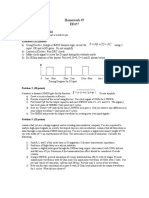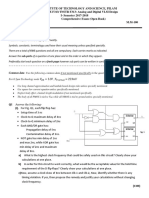0 ratings0% found this document useful (0 votes)
29 viewsHomework #3: Due Feb 24th, in Class
Homework #3: Due Feb 24th, in Class
Uploaded by
Parijat BasuThis homework assignment for a digital systems and circuits course contains three questions about designing and analyzing complex logic gates and circuits. Question 1 involves designing a complex gate to implement the function F=ABC+D and analyzing its logical effort and delay. Question 2 asks about determining the critical path delay and switching combination for a given logic circuit. Question 3 involves determining the optimum number of stages, implementing a given logic function, and sizing the gates to optimize the delay.
Copyright:
© All Rights Reserved
Available Formats
Download as PDF, TXT or read online from Scribd
Homework #3: Due Feb 24th, in Class
Homework #3: Due Feb 24th, in Class
Uploaded by
Parijat Basu0 ratings0% found this document useful (0 votes)
29 views2 pagesThis homework assignment for a digital systems and circuits course contains three questions about designing and analyzing complex logic gates and circuits. Question 1 involves designing a complex gate to implement the function F=ABC+D and analyzing its logical effort and delay. Question 2 asks about determining the critical path delay and switching combination for a given logic circuit. Question 3 involves determining the optimum number of stages, implementing a given logic function, and sizing the gates to optimize the delay.
Original Description:
sfk.nvg;srkgnsfz;b/
Original Title
HW LogicalEffort1
Copyright
© © All Rights Reserved
Available Formats
PDF, TXT or read online from Scribd
Share this document
Did you find this document useful?
Is this content inappropriate?
This homework assignment for a digital systems and circuits course contains three questions about designing and analyzing complex logic gates and circuits. Question 1 involves designing a complex gate to implement the function F=ABC+D and analyzing its logical effort and delay. Question 2 asks about determining the critical path delay and switching combination for a given logic circuit. Question 3 involves determining the optimum number of stages, implementing a given logic function, and sizing the gates to optimize the delay.
Copyright:
© All Rights Reserved
Available Formats
Download as PDF, TXT or read online from Scribd
Download as pdf or txt
0 ratings0% found this document useful (0 votes)
29 views2 pagesHomework #3: Due Feb 24th, in Class
Homework #3: Due Feb 24th, in Class
Uploaded by
Parijat BasuThis homework assignment for a digital systems and circuits course contains three questions about designing and analyzing complex logic gates and circuits. Question 1 involves designing a complex gate to implement the function F=ABC+D and analyzing its logical effort and delay. Question 2 asks about determining the critical path delay and switching combination for a given logic circuit. Question 3 involves determining the optimum number of stages, implementing a given logic function, and sizing the gates to optimize the delay.
Copyright:
© All Rights Reserved
Available Formats
Download as PDF, TXT or read online from Scribd
Download as pdf or txt
You are on page 1of 2
EEE 425/591
Digital Systems and Circuits
Spring 2016
Due Feb 24th, in class
Homework #3
Use n/p=2
Q1. Design complex gate gate such that F = ABC + D
(a) Draw a transistor schematic
(b) Size the transistors such that the resistance of each path is the same as the resistance of
the minimum sized inverter.
(c) What are the logical efforts for this gate inputs?
(d) What are the worst case delays for this gate driving a fan-out of four minimum sized
inverters using Elmore delay (use transistor-level diagram and do not ignore internal
parasitics)?
Q2. The gates in Figure 1 are all minimum sized. The input capacitance of a minimum sized
inverter is 10fF.
(a) Determine the delay of the critical path (in terms of the inverter delay)
(b) Determine the switching combination that activates the critical path.
A
B
X
C
CL=50fF
Y
F
G
Figure 1
CL=50fF
Q3. You are given the logic function: = + + +
The load at the output is 200fF, the input capacitance of a minimum sized inverter is 3fF.
(a) Determine the optimum number of stages
(b) Implement the logic function with the number of stages as close to the number you
found in part (a)
(c) When all gates are minimum sized, what is the delay in terms of the delay of the
minimum-sized inverter?
(d) Size the path to optimize the delay
(e) Determine the optimum delay
You might also like
- HW 5Document1 pageHW 5ottoporNo ratings yet
- ECE 342 - F14 - Midterm - Solutions PDFDocument4 pagesECE 342 - F14 - Midterm - Solutions PDFSandy ZakariaNo ratings yet
- University of California, Berkeley College of Engineering Department of Electrical Engineering and Computer Sciences Elad Alon Homework #4 EECS141Document2 pagesUniversity of California, Berkeley College of Engineering Department of Electrical Engineering and Computer Sciences Elad Alon Homework #4 EECS141Vidhya DsNo ratings yet
- 1 (A) The Logic Expression For The Circuit Is A (BC+D) 1 (B) 2 2Document7 pages1 (A) The Logic Expression For The Circuit Is A (BC+D) 1 (B) 2 2Suvendra SahooNo ratings yet
- Exercise 2Document3 pagesExercise 2momolololilo4No ratings yet
- VLSI Design Overview ProblemsDocument4 pagesVLSI Design Overview ProblemsJorge Ivan Canales VerdialNo ratings yet
- Ee141 HW5 2Document3 pagesEe141 HW5 2Vidhya DsNo ratings yet
- Use The Process Data Given at The End of The Exam Sheet For All ProblemsDocument4 pagesUse The Process Data Given at The End of The Exam Sheet For All ProblemsBasem Abd ElazizNo ratings yet
- CEDT Written Test Questions and PatternDocument14 pagesCEDT Written Test Questions and PatternDJNo ratings yet
- Model QPDocument6 pagesModel QPvlsisivaNo ratings yet
- December 2011: Amiete - Et (Old Scheme)Document4 pagesDecember 2011: Amiete - Et (Old Scheme)Anurag RanaNo ratings yet
- h3 f06 PDFDocument5 pagesh3 f06 PDFDevaraj SubrmanayamNo ratings yet
- 5 D J 2017 - S 1C E VII 17:00/18:15H - T: Departamento de Engenharia Electrotécnica 1 E E III / R 3 T 17:00/20:00H - EDocument2 pages5 D J 2017 - S 1C E VII 17:00/18:15H - T: Departamento de Engenharia Electrotécnica 1 E E III / R 3 T 17:00/20:00H - EHelder CruzNo ratings yet
- Isro Paper On 10Th August, 2008: Administrator Mr. VARUNA.V B.EDocument3 pagesIsro Paper On 10Th August, 2008: Administrator Mr. VARUNA.V B.EVivekSonkerNo ratings yet
- HW 5 UpdatedDocument1 pageHW 5 UpdatedottoporNo ratings yet
- 2020 FinalDocument3 pages2020 FinalBen ChouNo ratings yet
- Analog Electronics (0500625) SET 3Document8 pagesAnalog Electronics (0500625) SET 3Avinash PandeyNo ratings yet
- EC3058D-VLSI Circuits and Systems Winter Semester-2020-21Document2 pagesEC3058D-VLSI Circuits and Systems Winter Semester-2020-21Gamer AnonymousNo ratings yet
- IsroDocument10 pagesIsroSwetha ReddyNo ratings yet
- Electronics MQP Ii Puc 2023-24Document4 pagesElectronics MQP Ii Puc 2023-24sanjaykashiNo ratings yet
- EE537-Spring 2020 Digital Integrated Circuit Design Instructor: Engr. Dr. Nasir MohyuddinDocument2 pagesEE537-Spring 2020 Digital Integrated Circuit Design Instructor: Engr. Dr. Nasir Mohyuddinrao rehNo ratings yet
- Vlsi Module-3Document129 pagesVlsi Module-3Phanindra ReddyNo ratings yet
- Elect 6Document6 pagesElect 6dxbramNo ratings yet
- Lecture 27 SP24Document21 pagesLecture 27 SP24kritikagoel450No ratings yet
- IES Conventional Electrical Engineering 2012Document28 pagesIES Conventional Electrical Engineering 2012Srujan BobbyNo ratings yet
- DDDC87ECAA084E5DA4D2D77F7DC80391Document5 pagesDDDC87ECAA084E5DA4D2D77F7DC80391Sameer NandagaveNo ratings yet
- Gate - in 2011Document18 pagesGate - in 2011prabhjot singh1No ratings yet
- 5.2 CMOS Logic Gate Design: Serial or Parallel in Rs Transisto of NoDocument15 pages5.2 CMOS Logic Gate Design: Serial or Parallel in Rs Transisto of NoRaj AryanNo ratings yet
- 6th Microelectronic Olympiad in Armenia (2011) - TestsDocument12 pages6th Microelectronic Olympiad in Armenia (2011) - TestsMohammadAmin-DNo ratings yet
- Question 1 (50 Points) PipeliningDocument3 pagesQuestion 1 (50 Points) PipeliningMuhammad Zahid iqbalNo ratings yet
- تنافسي1Document9 pagesتنافسي1Sarah MohammedNo ratings yet
- Logical EffortDocument108 pagesLogical EffortPranav DarganNo ratings yet
- E3-238: Analog VLSI Circuits Lab 2: InstructionsDocument4 pagesE3-238: Analog VLSI Circuits Lab 2: InstructionsR SHARMANo ratings yet
- 2012 Basic Electrical Engineering: CS/B.TECH (OLD) /SEM-2/EE-201/2012Document7 pages2012 Basic Electrical Engineering: CS/B.TECH (OLD) /SEM-2/EE-201/2012abhrajitsahaNo ratings yet
- Indian Institute of Technology Kanpur Department of Electrical Engineering Practice Problems - 5Document1 pageIndian Institute of Technology Kanpur Department of Electrical Engineering Practice Problems - 5Kartik MittalNo ratings yet
- Linear Ic ApplicationsDocument4 pagesLinear Ic ApplicationsChinnu Cutiee28No ratings yet
- Questions On Digital Electronics and MicroprocessorsDocument12 pagesQuestions On Digital Electronics and MicroprocessorsHarendra KumarNo ratings yet
- Week5 VLSI Subsystems Assignment AnswersDocument5 pagesWeek5 VLSI Subsystems Assignment AnswersGPS INNOVATIVESNo ratings yet
- ISRO ECE Solved Question PaperDocument3 pagesISRO ECE Solved Question PapermnbvcxzNo ratings yet
- AVD2Document2 pagesAVD2ankushwreNo ratings yet
- Chapter4 FA16Document65 pagesChapter4 FA16Haseeb Chughtai100% (1)
- Assignment 6Document1 pageAssignment 6Akib Mohammad Azam ZaidiNo ratings yet
- EESB423 Sem1 1314 Assignment2Document3 pagesEESB423 Sem1 1314 Assignment2Shamraj KunnasagarNo ratings yet
- General Instructions To The CandidateDocument4 pagesGeneral Instructions To The Candidateapurv shuklaNo ratings yet
- Elect 5Document4 pagesElect 5dxbramNo ratings yet
- Model VLSI Question PaperDocument7 pagesModel VLSI Question Paperkumar_eeeNo ratings yet
- University of Edinburgh College of Science and Engineering School of Engineering and ElectronicsDocument15 pagesUniversity of Edinburgh College of Science and Engineering School of Engineering and ElectronicsSyed Fasih Ur RehmanNo ratings yet
- EEC501Document2 pagesEEC501raviNo ratings yet
- Assignment IDocument2 pagesAssignment Ivaishnavi priyaNo ratings yet
- 2012 Basic Electrical Engineering: Name Roll No. Invigilator's SignatureDocument7 pages2012 Basic Electrical Engineering: Name Roll No. Invigilator's SignatureKailas P NairNo ratings yet
- QP Eee 22 May2010 LdicaDocument6 pagesQP Eee 22 May2010 LdicaHari PrasadNo ratings yet
- Introduction To Reversible Logic Gates & Its Application: Prashant .R.Yelekar Prof. Sujata S. ChiwandeDocument5 pagesIntroduction To Reversible Logic Gates & Its Application: Prashant .R.Yelekar Prof. Sujata S. ChiwandeVani YamaniNo ratings yet
- Btech 2009 Practice Placement TestDocument17 pagesBtech 2009 Practice Placement TestDhruv BhatnagarNo ratings yet
- 1005 Es 201 Part IiDocument5 pages1005 Es 201 Part IisubhankargNo ratings yet
- Zipper Cmos Logic CircuitDocument15 pagesZipper Cmos Logic CircuitShreerama Samartha G BhattaNo ratings yet
- VLSI Quiz QuestionsDocument17 pagesVLSI Quiz Questionsjitu_40% (1)
- IES CONV Electronic Comm. 2000Document11 pagesIES CONV Electronic Comm. 2000gateandiesNo ratings yet
- Organic Light-Emitting Transistors: Towards the Next Generation Display TechnologyFrom EverandOrganic Light-Emitting Transistors: Towards the Next Generation Display TechnologyNo ratings yet
- Arizona State University: Name: Parijat Basu Student ID: 1210385823Document1 pageArizona State University: Name: Parijat Basu Student ID: 1210385823Parijat BasuNo ratings yet
- Speech Interface Vlsi For Car ApplicationsDocument4 pagesSpeech Interface Vlsi For Car ApplicationsParijat BasuNo ratings yet
- Notification BSNL TTA PostsDocument9 pagesNotification BSNL TTA PostsParijat BasuNo ratings yet
- AOT WebDocument24 pagesAOT WebParijat BasuNo ratings yet
- NFFLDocument6 pagesNFFLParijat BasuNo ratings yet
































































